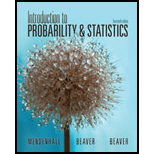
Concept explainers
(a)
To find the probability distribution for
(a)
Answer to Problem 5.94SE
The probability distribution for
Explanation of Solution
Since we are interested in the number of successes among a fixed number of independent trials with a constant probability of success, we can use the Binomial distribution.
The binomial probability is defined as,
Where
(b)
To find the value of
(b)
Answer to Problem 5.94SE
The value of
Explanation of Solution
Since we are interested in the number of successes among a fixed number of independent trials with a constant probability of success, we can use the Binomial distribution.
The binomial probability is defined as,
Where
Thus, the value of
This implies,
(c)
To find the probability that
(c)
Answer to Problem 5.94SE
The probability that
Explanation of Solution
Since we are interested in the number of successes among a fixed number of independent trials with a constant probability of success, we can use the Binomial distribution.
The binomial probability is defined as,
Where
Thus,the probability that
Thus,
For which the values of these
This implies,
Thus, we have finally that,
(d)
To find the largest value of
(d)
Answer to Problem 5.94SE
Explanation of Solution
Since we are interested in the number of successes among a fixed number of independent trials with a constant probability of success, we can use the Binomial distribution.
The binomial probability is defined as,
Where
We have from part (c) that
Now, we will find the probability of
For which the values of
Therefore,
Since
Want to see more full solutions like this?
Chapter 5 Solutions
Introduction to Probability and Statistics
